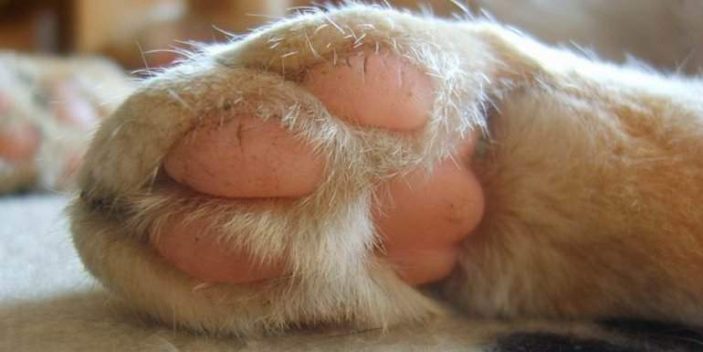Sweating or perspiration is the process by which sweat glands release liquid to help in body cooling down. In human beings, it commonly occurs on underarms, hands, and feet. However, other body parts can also perspire. What about cats?
Do cats have sweat glands, and do they perspire?
Yes. Feral, wild and domestic cats have sweat glands, also known as sudoriferous glands which are primarily found on a paw pad and other hairless places such as around their lips, nose, and anus. Additionally, their skin has these glands too. However, since their body is covered by fur, they do not help much.
Their sudoriferous glands become active due to thermal or psychogenic factors whose occurrence sends a message to their brain making these glands active.

Thermal factors are related to an increase in ambient or body temperature while the psychogenic factors include mental or emotional stressors as well as those that result from psychiatric or psychological disorders.[1]
When stressed, nervous or their body temperature is high, your cats will have sweaty paws (damp), or they may leave marks of their wet pad prints on the surface as they walk.
Therefore, it is obvious that cats can sweat just like dogs do. However, they have a minimal ability to perspire since their sweat glands are concentrated in their foot paw pads which happens to have a small surface area to cause substantial heat loss.
How does perspiration help them lower temperature? It is simple, the release of the liquids makes them feel cooler and as the liquids evaporate, they absorb some heat leaving the surface feeling cool.
A little to a class of chemistry, there is what is often referred to as the heat of vaporization which is the energy you must add to a liquid substance to change it into gaseous form. Typically, this energy amount is very high. Similarly, as sweat evaporates, it absorbs the heat of vaporization leaving the surface feeling cooler.
Coping with high excess heat
Unlike human being and some animals whose perspiration contributes a great deal in thermoregulation, in cats, sweating through their paws or few other hairless places we have mentioned doesn’t. It only helps to a small extent.
Fortunately, felines have other strategies to help release excess heat and lower their body temperatures. These strategies include going to shades, sprawl on a cool floor or surface, lick itself (take baths to help lose heat by evaporation), drink cold water, and some outdoor cats may disappear during hot summers, so on.
Additionally, they pant (when extremely hot or stressed). If your cat is panting too much, consider turning on your air conditioner, take her under a shed, give her ice treats, use a wet towel or cooling mats, groom her, and so on.
Note that excessive panting could be an indication of feline heat stress or heatstroke which requires an emergency treatment. Signs of a heat stroke include trembling, salivating, diarrhea, vomiting, seizures, their tongue, mouth or lips turning bright red and disorientation.
If sweating too much?
If your cat is sweating too much and it is not very hot, it could be a sign of excessive stress or anxiety that requires your vets attention. However, mild cases can be due to being excited, especially during petting.
Also, excessive drooling or salvation may be signs of a gastrointestinal or dental problem, and it should not be assumed to be normal perspiration.
Conclusion
While perspiration may be due to stressors or thermal cause, it is good to ensure that your feline friend does not have a fever. If you notice the abnormally high temperature and any other signs of fever, take her to your veterinarian.
